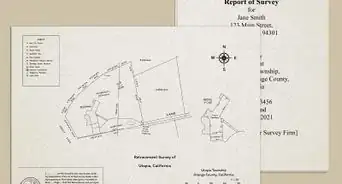This article was written by Jennifer Mueller, JD. Jennifer Mueller is an in-house legal expert at wikiHow. Jennifer reviews, fact-checks, and evaluates wikiHow's legal content to ensure thoroughness and accuracy. She received her JD from Indiana University Maurer School of Law in 2006.
This article has been viewed 30,681 times.
In many western states such as California, Colorado, and Texas, water is a scarce and valuable resource regulated by state government departments. Buying property does not necessarily mean that you also acquire the right to build a well or otherwise divert water onto that property. Instead, you must purchase separate water rights. The process can be incredibly complex and take several years. For that reason, you may want to hire a water attorney, especially if you anticipate your application for water rights will be contested.
Steps
Appropriating Water
-
1Locate a water source. If you've recently bought land and want to build a well, you must first determine where the water would come from.
- Different law may exist concerning surface water or ground water. For example, in Texas, the rights to surface water run with the land, while rights to ground water can be severed and sold separately from the land itself.[1]
- It is possible in many states for you to buy land but not have automatic rights to use the ground water running within or beneath that land if those rights have been severed and sold to someone else.[2]
- Water rights typically are sold using a contract which may specify total amounts of water to be withdrawn, a particular rate of withdrawal, and a term during which the rights are valid.[3]
-
2Contact the state engineer or water authority. The state's water authority maintains records on water sources in each region, who controls the rights to the water, and what rights are available.
- Since many water rights are held first by the state, the state commission has records regarding what water rights are available and who you must contact to purchase those rights.[4]
- Some states such as Texas maintain separate files on permits for irrigation water rights, which also specify the particular land to be irrigated. The sale of that land may transfer those irrigation water rights.[5]
- If you want to divert water from a river rather than groundwater from an underground aquifer, you may have to deal with a different authority. For example, river authorities in Texas operate independently of other water management entities and create their own regulations regarding the diversion of water from the rivers.[6]
- The state engineer's office may hire other engineers or geologists to collect and analyze data on the state's water supply. They use this data to create forecasts that help guarantee that the water rights you seek to buy will actually continue to be available for the term of your contract for water rights.
- Essentially, the state engineer's studies help determine whether your request for water rights will intrude upon the rights of those who came before you.[7]
Advertisement -
3Research the water law in your state. Different states may have different rules regarding which water rights claims have priority over others, and having a basic understanding of your state's law can help ensure you get the water you need.
- The priority of claims is important in determining what water rights remain to be bought or sold for a given water source. For example, Texas follows the rule that the first claim in time has the first priority to water rights for the water source.[8] Colorado adds the requirement that the first claim also must put the water to beneficial use.
- The "first in time" rule requires that additional water rights can be granted only if they would not disrupt earlier water rights.[9] [10] For example, suppose you require 10 acre-feet in water rights, and the nearest source has a capacity of 500 acre-feet. If there is only one older claim ahead of you for 250 acre-feet, the source has enough water to meet your needs and also satisfy all of the older claim. However, if the source only has a capacity of 255 acre-feet, it cannot meet your need and still fulfill the older claim, which has priority over yours.
- In addition to state water law, your particular water district may have its own rules regarding the transfer of water rights for sources within that district. For example, most water districts in Texas have specific rules governing the transfer of water rights related to wells located in those districts.[11]
- The essential elements of water appropriation are that you divert water and apply that water to beneficial use. Beneficial use typically includes irrigation, watering your livestock or garden, or for use in the home.[12]
-
4Negotiate a contract. If another individual or business has priority rights to the water you want to use and there are no remaining open water rights for the water in that source, you must negotiate a contract to purchase some or all of their water rights.
- The price and relative value of water rights depends not only on the location of the source but the location of the rights on the priority list for that source.[13]
- Some states such as Texas also have a water bank or a water trust that works to protect water rights and facilitate the transfer of water rights between buyers and sellers.[14]
- In some states such as Utah, water rights are classified as real property and bought and sold just as land or homes are sold. These rights have predetermined usages and rates, and are recorded with the county recorder the same as deeds to land. For example, a water right might be sold for a single family residence, two head of cattle, and irrigation of a quarter-acre garden.[15]
-
5Conduct a field survey. To begin your claim for water rights, you typically must make your intentions to use the water clear to the public.
- For example, in Colorado, you must first appropriate water by making a physical display of your intent to divert and use the water. Conducting a field survey puts people in the area on notice that you are searching for and intend to use the area's ground water.
-
6File a well permit application. One way to publicly proclaim your intent to divert water from the water source is to file a well permit application for your property.
- In Utah, for example, water well drillers must be licensed by the state, and cannot drill a well unless you have permission from the state engineer to do so.[16]
- You must file a different application depending on whether your area is open, restricted, or closed to water rights.[17] When you file your application, you must be prepared to pay a fee ranging from $150 to $1,000.[18]
- A well permit application also serves as sufficient notice to others who own water rights to the source in your area that you are in the process of buying water rights.
- Well permits are reviewed by the state engineer's office, which determines the amount of water available and makes sure no new wells will injure existing water rights.
- In some states such as Colorado, certain types of wells, including wells for household use only, are exempt from the general priority system. These wells operate under conditional permits and typically are only allowed where a municipality or rural water district cannot provide water to the property.
Filing a Water Right Application
-
1Download the appropriate application. The water court typically will have an application available online that you can use.
- Once you've downloaded the application, read it and make note of the information you'll need to include.
- Your application typically must specify the scope of the water rights you want to buy or claim, which includes the amount of water to be diverted, the rate of diversion, and the purpose of your use.[19]
-
2Gather the required information. After you've read the application, conduct whatever surveys or other studies are necessary to get the information you need to complete the application.
- Your application typically will include the type of water rights, location where you intend to divert the water, name of the source, dates you intend to use the water, how you intend to divert the water, the rate at which the water will be appropriated, and what you intend to use it for.
-
3Submit your application. Once you've completed your application, you must file it with the water court in the district where your water source is located.
- The date on your application sets your priority for water rights from the source you've chosen.
- In some states such as Colorado, applications are filed with judges who only hear cases involving water rights and review applications for water rights.
-
4Publish legal notice. Generally you must publish a legal notice in a local newspaper of record that provides the public with notice of your application.
- For example, in Colorado, you must publish legal notices for two months. During that time, anyone who disagrees that you should be granted permission to buy water rights can file a statement in opposition with the water court.
-
5Comply with other legal requirements. The water court may have additional surveys or notices that must be completed before the judge will make a final decision on your application.
- In some states such as Colorado, your application also will be reviewed by an engineer, who will make a recommendation to the court as to whether your application should be approved or denied.
Going to Trial
-
1Prepare for trial. If others contest your application and you cannot arrive at a settlement, the water court will schedule a trial to hear all sides on the matter.
- You cannot purchase water rights until your application is approved. The court reviews the recommendation from the engineer, as well as any other information from prior rights holders.
- You also may want to consider hiring your own water engineer to evaluate your application and perform additional surveys before you go to trial. A water engineer can help you identify the type of water rights you need and how you should categorize your use.[20]
-
2Consider hiring an attorney. If you haven't already retained an attorney, it may be in your best interest to find someone experienced in water law to represent you at trial.
- Water rights can be extremely complex, and require a lot of time and work. An experienced water rights attorney can protect you throughout the transaction.[21]
- Before you hire a water rights attorney, interview him and make sure he is familiar with the area and has an understanding of and experience with real estate contracts, since water rights typically are considered real property and governed by the same laws as real estate transactions.[22]
- A good water rights attorney also will know how to search the records for prior claims with priority, and assess your chances that your application will be approved.[23]
-
3Appear at water court on the scheduled date. At trial, you will have an opportunity to explain to the judge why your application should be granted.
- If there is no opposition to your application for water rights, you still must appear. The judge may ask you questions or request documentation or other clarification regarding the information you included in your application.
- If someone does contest your application, you must appear before a judge, who will make the final determination on whether your application should be approved.
- If your application for water rights is approved, you are free to purchase your water rights. You will receive a permit to use the amount of water you described in your application.
References
- ↑ http://www.twdb.texas.gov/publications/reports/infosheets/doc/WaterRightsMarketingBrochure.pdf
- ↑ http://www.twdb.texas.gov/publications/reports/infosheets/doc/WaterRightsMarketingBrochure.pdf
- ↑ http://www.twdb.texas.gov/publications/reports/infosheets/doc/WaterRightsMarketingBrochure.pdf
- ↑ http://www.twdb.texas.gov/publications/reports/infosheets/doc/WaterRightsMarketingBrochure.pdf
- ↑ http://www.twdb.texas.gov/publications/reports/infosheets/doc/WaterRightsMarketingBrochure.pdf
- ↑ http://www.twdb.texas.gov/publications/reports/infosheets/doc/WaterRightsMarketingBrochure.pdf
- ↑ http://corporate.findlaw.com/business-operations/water-rights-law-prior-appropriation.html
- ↑ http://www.twdb.texas.gov/publications/reports/infosheets/doc/WaterRightsMarketingBrochure.pdf
- ↑ http://corporate.findlaw.com/business-operations/water-rights-law-prior-appropriation.html
- ↑ http://www.waterrights.utah.gov/wrinfo/faq.asp
- ↑ http://www.twdb.texas.gov/publications/reports/infosheets/doc/WaterRightsMarketingBrochure.pdf
- ↑ http://corporate.findlaw.com/business-operations/water-rights-law-prior-appropriation.html
- ↑ http://www.twdb.texas.gov/publications/reports/infosheets/doc/WaterRightsMarketingBrochure.pdf
- ↑ http://www.twdb.texas.gov/publications/reports/infosheets/doc/WaterRightsMarketingBrochure.pdf
- ↑ http://www.waterrights.utah.gov/wrinfo/faq.asp
- ↑ http://www.waterrights.utah.gov/wrinfo/faq.asp
- ↑ http://www.waterrights.utah.gov/wrinfo/faq.asp
- ↑ http://waterrights.utah.gov/wrinfo/forms/fees.asp
- ↑ http://www.twdb.texas.gov/publications/reports/infosheets/doc/WaterRightsMarketingBrochure.pdf
- ↑ http://www.watercolorado.com/water_rights2.shtml
- ↑ http://www.watercolorado.com/water_rights2.shtml
- ↑ http://www.watercolorado.com/water_rights2.shtml
- ↑ http://www.watercolorado.com/water_rights2.shtml









































































